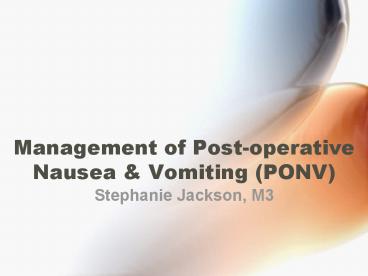Management of Postoperative Nausea - PowerPoint PPT Presentation
1 / 16
Title:
Management of Postoperative Nausea
Description:
Management of Post-operative Nausea & Vomiting (PONV) Stephanie Jackson, M3. Incidence of PONV ... Meyer et al, Anesth Analg 2005; 100:373-7. Dexamethasone vs ... – PowerPoint PPT presentation
Number of Views:561
Avg rating:3.0/5.0
Title: Management of Postoperative Nausea
1
Management of Post-operative Nausea Vomiting
(PONV)
- Stephanie Jackson, M3
2
Incidence of PONV
- Morphine, which is standardly used in
patient-controlled analgesia (PCA), provides
excellent control of patient postoperative pain.
It is excellent in that patients use less drugs
than if they were treated by medical staff. - But morphine doesnt come without its side
effects. The biggest being - Postoperative Nausea Vomiting
3
Facts
- PONV increases
- Time spent in recovery
- Need for nurses
- Need to admit overnight
- This all leads to increased healthcare costs.
- More than 25 of patients report experiencing
PONV, with numbers reaching as high as 80 in
high risk populations.
4
PONV risk factors
- Female gender
- Nonsmoking status
- History of motion sickness or PONV
- Use of postoperative opioids
- Type of surgical procedure (e.g. ambulatory
gynecologic laparoscopy reports 88)
5
Available Drugs
- Phenergan (Promethazine) H1 antagonist, central
peripheral - Kytril (Granisetron) serotonin (5-HT3)
inhibitor, given IV in cancer pts - Anzemet (Dolasetron) serotonin (5-HT3)
inhibitor - Zofran (Ondansetron) - serotonin (HT3) inhibitor
- Inapsin (Droperidol) inhibits DA a receptors
- Reglan (Metoclopramide) stimulates upper GI
motility
6
Intravenous crystalloid infusion
- Prospective, randomized, double-blind clinical
investigation - 30ml/kg vs 10 ml/kg infusion to combat
preoperative hypovolemia. - Preoperative fasting creates a hypovolemic state
that causes under-perfusion of gastric mucosa
delaying return of bowel function. - They found that 30mg/kg significantly reduced
PONV at 0.5h 48h. - Magner et al., British Journal of Anaethesia, 93
(3) 381-5 (2004)
7
Advantages of CSL-30
- Inexpensive, non-pharmacological therapy
- Eliminates adverse drug effects side-effects
- Magner et al., British Journal of Anaethesia, 93
(3) 381-5 (2004)
8
Dolasetron vs. Ondansetron
- 12.5 mg iv Dolasetron vs 4 mg iv Ondansetron
- Dolasetron was found to be more effective,
requiring less rescue emetics - Price comparison including cost of rescue emetics
showed Dolasetron as being more cost-effective. - 4 major hospitals in Washington saved 500,000
over 1 year - Meyer et al, Anesth Analg 2005 100373-7
9
Dexamethasone vs Droperidol
- A study compared Droperidol with varied doses of
Dexamethasone. - 2 mg 4 mg of Dexamethasone showed no difference
compared to saline. - 8 mg 12 mg Dexamethasone 0.10 mg of
Droperidol all reported higher patient
satisfaction by reducing N/V. - Higher doses of Droperidol cause excessive
sedation. - Lee Et Al, Anesth Anal 2004 981066-71
10
Dexamethasone vs Droperidol
- Complete response (no post-op N/V, no need for
rescue emetics) was shown at 72.2 for 8 mg
78.9 for 12 mg of Dexamethasone compared to
42.9 for saline. - In 2001 the FDA gave Droperidol and black box
warning related to cardiac toxicity (QT
prolongation. - Lee Et Al, Anesth Anal 2004 981066-71
11
Granisetron vs. Ramosetron
- 0-24 hrs after anesthesia
- 17 with granisetron
- 10 with ramosetron
- 47 with placebo
- 24-48 hrs after anesthesia
- 27 with granisetron
- 7 with ramosetron
- 53 with placebo
- Not available in the US
- Fujii et al, American Journal of Therapeutics
(2004) 11(4)
12
Cimetidine
- Cimetidine, an H2 antagonist, has been used to
increase gastric pH reduce gastric volume to
avoid aspiration due to anesthesia. - Cimetidine has also shown elicit antinociception.
- A pre-op group received 4mg/kg preoperatively,
while the post-op group received saline.
Postoperatively the pre-op group received saline,
while the post-op group received 4mg/kg of
cimetidine. - The control group received saline both pre-
post- operatively. - They found no difference in either group.
- Y-Y. Chia et al., Acta Anaesthesiol Scand 2005
49 865-869
13
PCA diphenhydramine
- Diphenhydramine blocks muscarinic-cholinergic
receptors in the vestibular pathways and vomiting
center. - Diphenhydramine was added to the morphine at a
diphenhydramine-to-morphine ratio of 4.81 (group
3) 1.21 (group 2) to women who had undergone
total abdominal hysterectomies. - Group 3 showed significant improvement, while
Group 2 showed no improvement over group 1
(normal saline). - Nausea 31.6 (group 3) vs 67.6 (group 1)
- Vomiting 15.8 (group 3) vs. 40.5 (group 1)
- Severe nausea 2.6 (group 3) vs 24.3 (group 1)
- Rescue antiemtics 5.3 (group 3) vs 24.3 (group
1) - Lin et al., British Journal of Anaesthesia 94
(6) 835-9 (2005)
14
Cost Comparison
- Phenergan (Promethazine) 12.5mg 0.37, 25mg
0.60 ,50mg 0.90 - Kytril (Granisetron) 1mg 50.00
- Anzemet (Dolasetron) 50mg 54.58, 12mg
13.65 - Zofran (Ondansetron) 4mg 22.30
- Inapsin (Droperidol) unknown
- Reglan (Metoclopramide) 5mg 0.72, 10mg
1.17
15
Summary
- 30ml/kg of intravenous crystalloid infusion vs 10
ml/kg - Dolasetron vs. Ondansetron
- Ramosetron vs. Granisetron
- Dexamethasone vs. Droperidol
- Diphenhydramine
16
Other factors to research in the future
- Smoking as an anti-emetic
- PONV affected by female sex hormones































